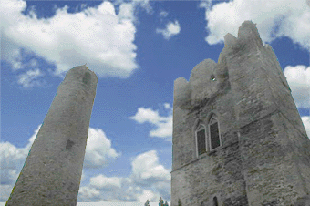
 |
Historic Swords | Restaurants | Public Houses | Shopping | Accommodation |
Historic Swords
| Swords is an ancient settlement, dating back to 560 AD when it was founded by St. Colmcille. Legend has it that the saint blessed the local well, thus giving it its name, 'Sord' meaning clear or pure. The site of the well is just one of the attractions which can be visited today. St. Colmcille's monastic settlement survives high above the town to this day, with its 9th Century Round Tower and 13th Century Mediaeval Square or Norman Tower. Even those days, Swords was a very popular destination for visitors to the Fingal area though the visitors were rather less welcome - the town was burned by invaders at least ten times during the 9th and 10th Centuries. Swords Castle didn't fare much better and has been lying in ruins since 1325 AD after experiencing the brunt of the Bruce invasion and many local uprisings. This is a phenomenon which Fingal County Council and FAS are now reversing with their comprehensive restoration programme. All of these ancient and mediaeval ruins can still be visited today and have been an invaluable amenity to the area. You cannot take even the most casual trip through Swords without taking a trip back in time, such is the richness of it historical tradition. In later years the town played host to such historical figures as Dean Jonathan Swift, who often visited the famous Molesworth family at nearby Brackenstown. Sean O'Casey immortalised the area itself in his play 'Shadow of a Gunman'. The bridge at Knocksedan still bears a plaque to the memory of the 1916 volunteers, who used it as a meeting point before the Rising. Beyond is the road along which Cromwell's army traveled, on their way back to Drogheda. St. Colmcille's Church in the town dates from 1827 and among the graves is a granite monument to the memory of Andrew J Kettle, known as 'Parnell's right-hand man'. Together with more recent developments which has made Swords on of the fastest growing towns in the European Union. | |
| Top of Page |
|
| Swords Castle |
|
 |
Construction work on the castle began in the 12th Century with the appointment of the first Norman bishop of Dublin, John Comyn. The castle was founded on the Well associated with St. Colmcille and is prominently situated in the Ward River Valley Linear Park. The castle is unusual in that, with the perimetre of 305 meters, it is far larger than normal for an Irish Castle and was constructed in piecemeal fashion over a period of 400 years. As well as being the home of the Archbishops of Dublin, it is said that parliaments were held in the great hall of the castle. In 1583 Sir Henry Sydney, the Land Deputy, settled Dutch refugees in the Castle, who repaired and extended the dwelling. By 1641 Swords Castle was chosen as a rendezvous for the Anglo-Irish families of the Pale. Currently the castle is the only fortified residence of the Archbishop of Dublin to survive in a reasonable condition. |
|
As it stands at the moment Swords Castle presents a vivid snap-shot of 15th century life, comprising a gatehouse, apartments for knights, a chapel, banqueting hall, the all-important Archbishops apartments and two large towers, one of which was the home of the area's constable and his family. Swords Castle was lying idle for a number of years before it was bought from the Cobbe family by Dublin County Council in 1985. The castle and the surrounding lands were acquired for the provision of the Ward River Valley Regional Park. The story of the castle before was one of neglect. |
 |
|
The Parks Department carried out a number of studies, including a conservation study of the entire area. They then undertook a tourism study before submitting a plan to Fingal County Council in early 1995.
In March 1995 a plan for the phased restoration of the castle was approved by the Council and FAS, along with the parks Department, started the work shortly afterwards. The project is being sponsored by the Swords Castle Restoration Committee. The council commissioned a number of historical and archaeological studies of the castle and it environs with a view to its restoration as a major cultural, educational and tourist centre, similar to Malahide and Ardgillan Castles. The castle contains a tourism information centre at which visitors can find out more information about the castle and its history, is open from Monday to Friday. | Top of Page |
| In the 10th Century the Round Tower was used as a look-out post and housed the bloody remains of King Brian Boru and his son Murrough after the famous Battle of Clontarf on their way to be buried in Armagh. During the course of the decisive battle the Irish king’s army had routed the Viking invaders and at one point captured their flag. The black raven featured on the flag remains the symbol of Fingal today. Indeed the area gets its name from the Viking words ‘Fionn Gall', meaning 'land of the fair haired stranger', the term for Vikings who had settled in the area from the 8th Century onwards. After the battle many of the defeated Vikings remained on as residents in the area enriching the local Gaelic traditions with their own indigenous crafts such as wood carving and turning, wrought iron working, pottery, sculpting and garment design. The tower gives an unrivaled view of Fingal as far as the Mountains of Mourne on a clear day. John Sweetman, the United Irishman and friend of Wolfe Tone, was buried in the shadow of the two towers. | 9th Century Round Tower and  13th Century Mediaeval Square / Norman Tower |
| Top of Page |
|
Carnegie Library |
Home of Swords Museum
Fingal Heritage Group |
| Top of Page |
|